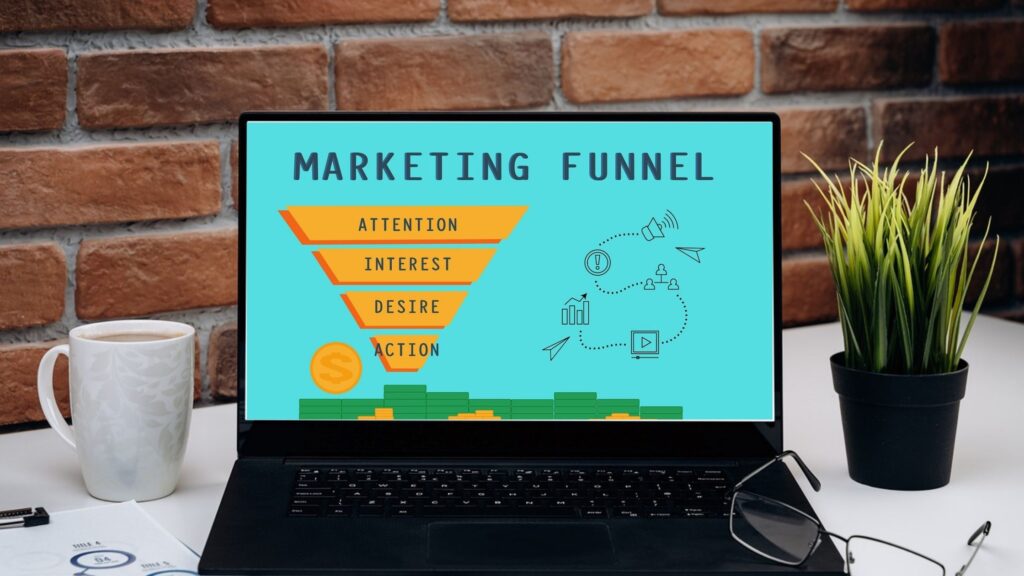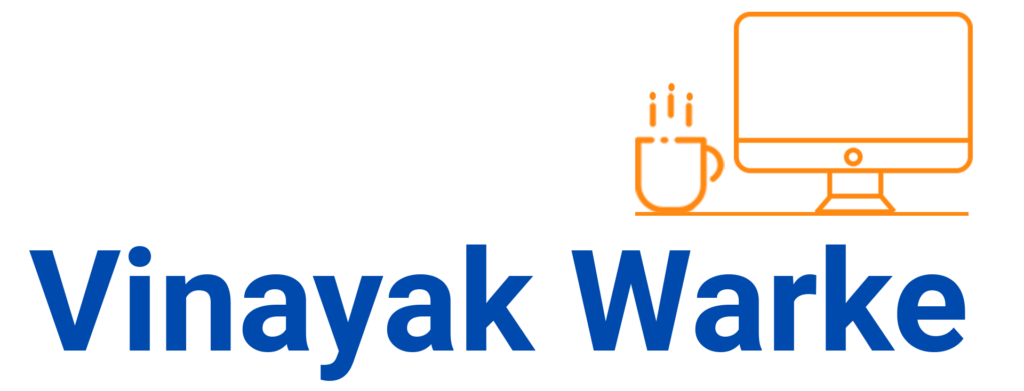In this blog post, you will learn about the marketing funnel concept, with real-life examples, how to use the marketing funnel, and create one for any business.
Here is a list of topics covered in this article:
- What is marketing funnel?
- The AIDA funnel and how to use it
- The TOFU-MOFU-BOFU marketing funnel & how to use it
- Real-life example of how a marketing funnel works
- Digital marketing funnel
- Marketing funnel extension – customer loyalty & brand advocacy
- How to create a marketing funnel?
- Marketing funnel vs Sales funnel
- Benefits of a marketing funnel
- Conclusion
What is marketing funnel
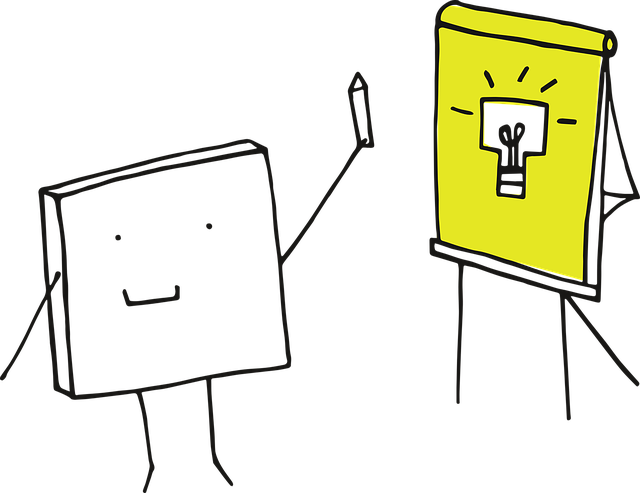
To begin with, let’s understand what a marketing funnel is.
Here I will explain the overall concept of a marketing funnel, and later we will look at the different types of funnels and how to use them.
The marketing funnel is a model that represents the customer’s journey with a business, starting from becoming aware of the company’s product or service to end with purchasing the product or service and further extending to repeat purchase.
The marketing funnel is a framework that businesses use to turn target audiences who are unaware of their product into loyal customers of their product.
It represents the various steps or stages that a target customer goes through, before purchasing the product or service. Broadly these stages include attracting target customer attention, turning them into leads, engaging them with the brand and turning them into hot prospects, and finally converting them into making a purchase.
Identifying and analyzing these steps in the customer journey gives the company an opportunity to influence the customer behavior at every stage and lead them towards the final step of doing a purchase. Companies optimize their marketing efforts based on analyzing the customer behavior at each stage of the funnel.
Businesses use various marketing tactics and techniques at every step of the marketing funnel, to influence the customer journey. This includes using various marketing channels & tools and more importantly using various pieces of marketing content & communication to influence the customers.
Customers engage with the company and its brand at the various stages of the funnel. With each stage, they are evaluating how well the brand will serve their needs and are moving towards making a purchase decision.
The main objective of the marketing funnel concept is to influence more and more customers to move to the next stage in the funnel and finally to the bottom of the funnel.
It is called a funnel because it narrows down with every stage. Just like an actual funnel, the funnel is at its broadest at the top where target customers become aware and narrows down the most at the bottom where prospect customers make a purchase. There is a drop in the number of customers from the top of the funnel (1st stage) to the bottom of the funnel (last stage).
There are few types of marketing funnels or models in use, however, the fundamental concept of the marketing funnel remains the same – moving prospect customers from awareness to conversion.
Now let’s look at some of the popular marketing funnels and how to use them.
The AIDA Funnel & how to use it
AIDA funnel is one of the early and long-standing marketing funnel models. This funnel has 4 stages – Attention, Interest, Desire, Action, and hence its name AIDA.
AIDA is more of a sales/purchase funnel that it is linear in nature.
The AIDA funnel is slightly more relevant to traditional marketing, though its principles can be applied to digital marketing as well.
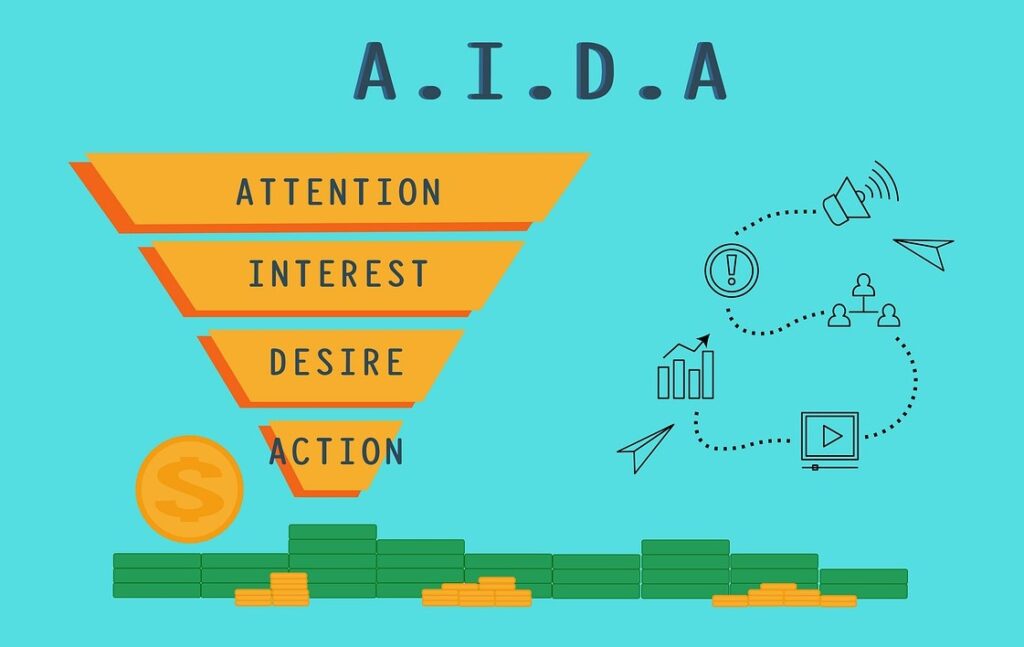
Let’s look at each of the 4 stages in the AIDA marketing funnel and how to use this funnel:
Attention
At this initial stage at top of the funnel, companies attract the attention of the target customers by advertising their product/ service.
The marketing content and communication is focused on creating awareness about the product and projecting how the product is a solution to the customers’ needs.
Companies run advertisements on TV, newspapers, social media, and billboards to attract attention. They create website content, practice SEO, create social media posts and do PR to attract attention and create awareness about the product.
This is the stage where target customers become aware of the company’s brand/ product.
Interest
Once the target customer is aware of the product, the company starts building their interest by communicating the features and benefits of the product.
The content and communication now focus on building more interest by sharing further information on the product features, how this benefits the customers and how it can solve the customer needs.
Companies communicate more details about the product through advertisements, product descriptions on the website, product brochures, product demos, product videos, and others. Product features are highlighted to communicate how the product is unique in satisfying customer needs.
This is the stage where customers develop interest and start doing active research around the company’s product or service.
Desire
The next stage is the Desire stage, where the company starts making an emotional connection with their prospective customers by communicating their brand story and engaging with the prospective customers.
The content and communication focus on creating a strong desire for the product by showing them the end state of their needs after using your product.
Companies showcase the various use cases of the product and the state of the customer after his needs are satisfied by using the product. Case studies that highlight “before and after” stages of customers are used here.
The brand starts to actively interact with the prospect customers and move them to a favorable position in their minds, for the product. The idea is to move the customer position from “I like it” to “I want it.”
The customers now believe the company’s product to be the best available solution for their needs.
Action
This is the stage where the brand initiates the target customer to take action – mostly a trial or a purchase of the product.
The content and communication focus on inducing action by giving them an attractive offer and showing them an easy path to purchase the product. Brands do a sales pitch at this stage and give an attractive offer to induce action.
Companies communicate a clear call to action to the prospects at this stage. The call to action could be to purchase the product or sign-up for a free trial. Companies use sales pitches, attractive offers, sales pages, sales videos, customer testimonials, and others to induce action from the prospects.
The customer takes action at this stage, which is mostly the purchase of the product.
The TOFU-MOFU-BOFO Funnel & how to use it
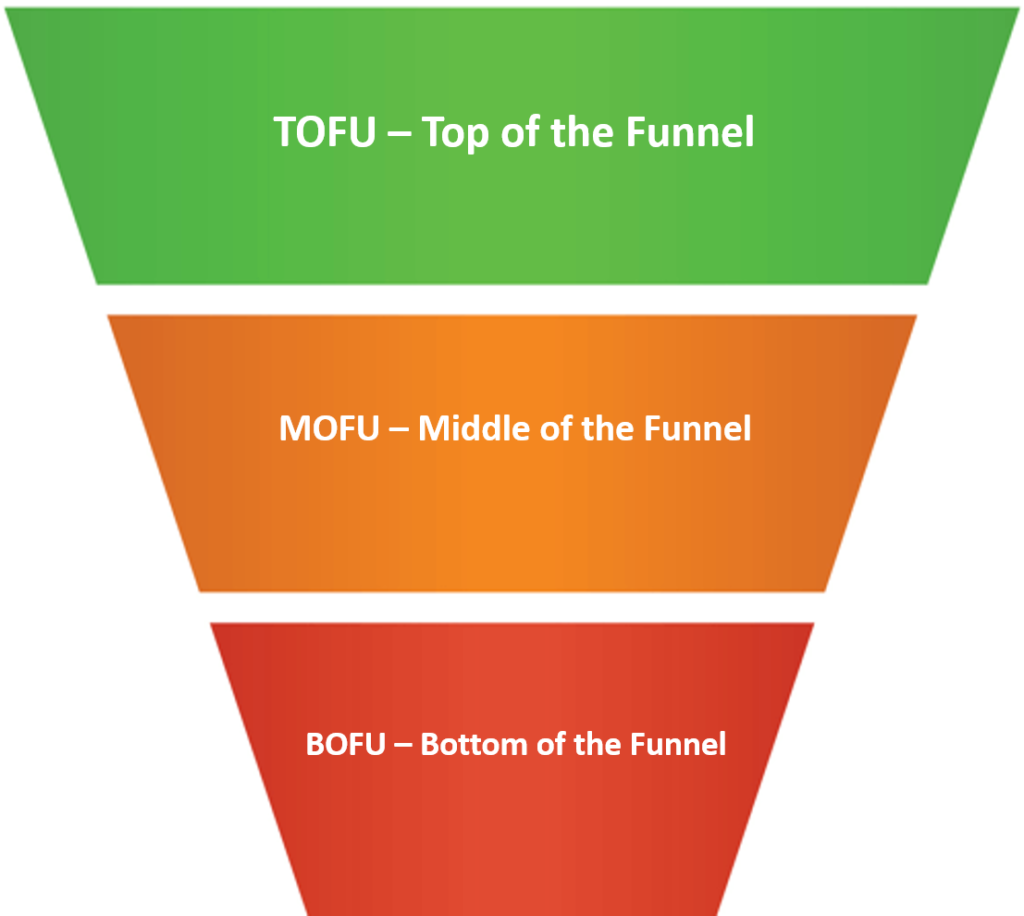
One of the simple marketing funnels in use during modern times is called the TOFU-MOFU-BOFU funnel.
As the name suggests, this funnel has 3 stages. TOFU stands for Top of Funnel, MOFU for Middle of Funnel, and BOFU for Bottom of Funnel.
This model is a popular one in use in today’s age of digital marketing. The fundamental principles remain the same as the AIDA model.
The 3 simple stages in this model are used to create relevant digital marketing content, in order to influence target customers to move further through each stage of the funnel.
This model is also more relevant to businesses that rely on lead generation, lead nurturing and lead conversion for acquiring paid customers.
Let’s look at the 3 stages in the TOFU-MOFU-BOFU funnel and how to use this funnel:
TOFU
TOFU i.e. Top of the Funnel is the awareness stage. It relies on the fact that target customers, who are facing a problem, have a need, and are looking for a solution.
Companies try to attract their attention and create awareness towards the product being a solution for their needs. This is the widest end of the funnel.
At this stage, target customers may not be aware of the company’s product and about it being one of the possible solutions to their needs.
Companies attract the attention of the target customers by running marketing campaigns. They provide content that introduces their product and positions it as a possible solution to the target customer needs.
The objective is to create visibility and awareness for their brand and try and capture the interested target customers’ details in the form of leads.
Example of TOFU
Let’s consider the case of an online chess training company for kids. Their target customers are parents looking for an online chess training program for their kids.
The Chess training company will target these parents with campaigns. The content will introduce their brand and communicate details of the chess training program.
They will try and capture details (email/ phone) of the interested parents, promising a free demo or further information.
Content used at TOFU
Typical content used by brands at this awareness generation stage would be blog posts, social media posts, videos, infographics, podcasts, e-books, website content, checklists, others.
Channels used at TOFU
The marketing & communication channels used by brands to create awareness are paid advertising, SEO, social media, webinars, PR, others.
MOFU
MOFU, i.e. Middle of the Funnel is the consideration and evaluation stage. Prospect customers have identified their needs and are evaluating solutions for their needs. They are considering your product as one of the solutions.
Companies try to convince prospects as to why their product is the best solution for satisfying their needs.
This is the middle of the funnel, narrower than the top due to a drop in the number of target customers who move from being aware to considering and evaluating your product.
At this stage, companies provide a lot of detailed information about their product and its benefits in solving the customer needs. They also provide information on how their product is unique and better than the competition in solving customer problems. This helps the customers in making a decision.
Brands develop trust by engaging with prospective customers at this stage. This is done through multiple contacts and providing high-quality content and information. Without developing trust, prospects will not progress to the next stage of purchase.
At the end of this stage, prospects develop trust and make a decision towards choosing a product. This is the stage where cold leads are turned into warm leads and further into hot leads through constant contact and exposure to the brand’s content.
Example of MOFU
In the above case of chess training product, prospect parents who have given their email ids or visited the training company website/ landing page will be sent a drip email marketing campaign.
Each email will have useful content around the training program such as – information about the top quality trainers, program module and how its best suited to train their kids, various levels of proficiency the kids would achieve with the program, details about the chess competitions they would participate in, and others.
Retargeting ads will be used to reach the target parents who did not share contact details but visited the website.
Content used at MOFU
ypical content used by brands at the MOFU stage would be case studies, white papers, videos, tips and demos on their product usage, subscription newsletter, live events, product reviews, and others
Channels used at MOFU
The marketing & communication channels used by brands at this stage include email marketing, retargeting ads, live webinars, website content, review sites, others.
BOFU
BOFU, i.e. Bottom of the Funnel is the conversion or purchase stage. Prospect customers who have turned into hot leads in the MOFU stage are now ready to commit & convert and are looking to do a purchase. They have made a decision on the product.
At this stage, brands try to convert hot prospects into paid customers by making a sales pitch, offering attractive incentives and by providing testimonials of satisfied customers.
When the leads are hot and have developed trust and conviction, sales becomes natural and brands do not need to do any hard selling. They may just need a small push through an attractive offer, creating some urgency, and a little reassurance from the brand.
This is the narrowest end of the funnel, as there will be a further drop in the number of prospects who would ultimately convert into paid customers.
Example of BOFU
In the case of the chess training company, the prospect parents who have turned into hot leads will be now invited to a live sales webinar. In the webinar, they would be addressed by the company professionals. Satisfied customers would interact and share their positive experience in the webinar.
At the end of the webinar, they would be given an attractive offer to convert into paid customers during the webinar itself.
Alternatively, the company would send them an email or retarget them with a sales ad, and take them to a sales landing page. This page would have the sales pitch, a sales video, customer testimonials, and communicate an attractive offer/ incentive to convert.
Customers can complete the purchase on this sales page itself.
Content used at BOFU
Typical content used by brands at the BOFU stage would be sales pitch, sales videos, product demos, customer testimonials, FAQs, incentives in the form of money back guarantee, cash discounts, and free gifts
Channels used at BOFU
The marketing & communication channels used by brands at this stage include sales pages, sales webinars, website purchase page, telemarketing, others.
Real-life example of how marketing funnel works
You may have this question – how exactly does a marketing funnel work in real life?
The marketing funnel works through its various funnel stages. It starts from the broadest end at the top of the funnel that attracts a large number of target customers.
It then gets narrowed at the middle section where part of the audience attracted at the top are now considering and evaluating the product for solving their needs.
It gets further narrower at the bottom of the funnel, where some prospects from the middle section convert into making a purchase.
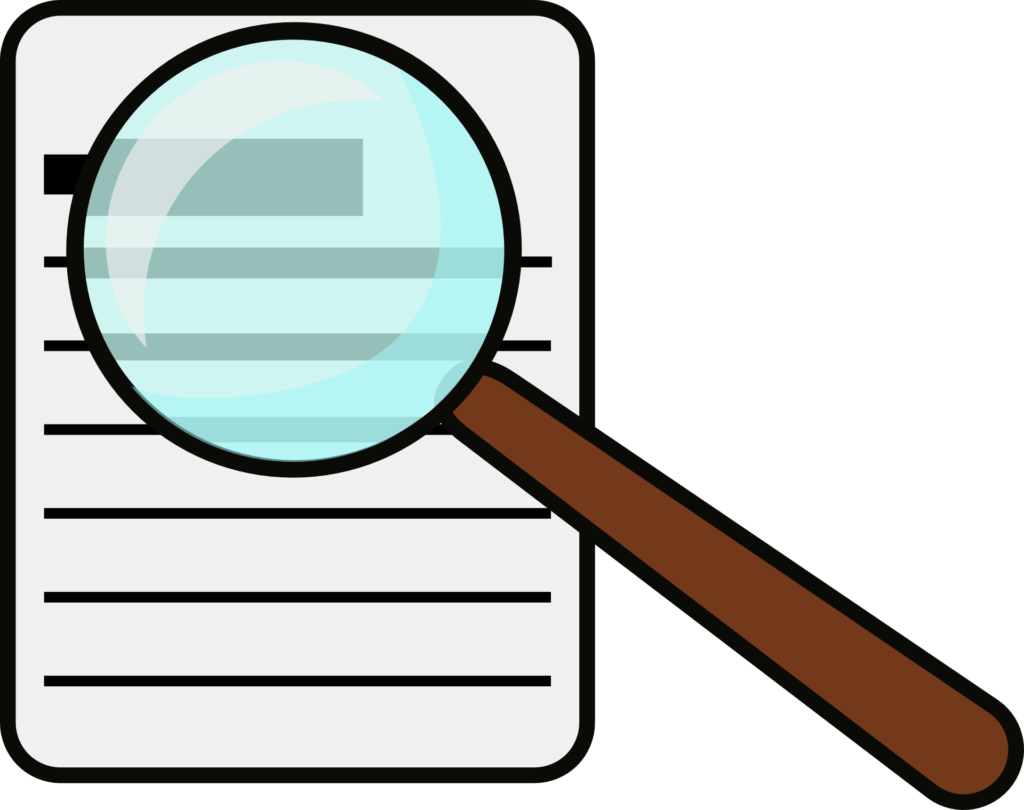
Let’s understand how a marketing funnel works through a real-life example from my past corporate stint.
During one of my past stints as a Marketing Head, we marketed a magazine that provided expert buying advice to consumers.
The content in the magazine was extremely high quality and high value. We used to sell paid annual subscriptions for this monthly magazine + website content.
The marketing goal was to acquire annual paid subscribers for the bundled product of magazine + website content.
We had designed a TOFU-MOFU-BOFU marketing funnel for acquiring these paid subscribers:
At the TOFU stage, we used to run awareness campaigns using email marketing, SEM, and display ads. The communication introduced the brand, highlighted its usage, and offered a free trial of the latest magazine copy.
This free copy of the magazine was the lead magnet. Interested prospects had to visit a landing page and fill a lead form to avail themselves of this free magazine.
This landing page had brand messaging around the magazine content and its benefit to the consumers in making correct buying decisions and saving money.
Interested prospects had to fill the lead form and then get the free magazine copy.
At the MOFU stage, we sent a free copy of the latest magazine to the leads. Following this, we sent a series of emails that had interesting content around how the magazine offered expert buying advice by testing the products.
The content also had details about how our advice was independent and trusted since we did not take any advertisements from the product manufacturers.
The leads were now engaging around the magazine and other content through a series of communication from our end. Through this, they were developing trust and confidence.
In the process, some of these leads turned to warm leads, and a few others turned into hot leads.
At the BOFU stage, we used to send a conversion email, with an attractive discount or a free gift offer on a paid annual subscription to the magazine.
A click on the email would take the hot prospects to a landing page where they could complete the purchase.
We also used to do telemarketing by calling the hot leads and converting them into paid subscribers on phone.
So this is how the marketing funnel operates in the real world, in turning target customers into hot prospects and then converting them into making a purchase.
Digital Marketing Funnel
Today’s marketing is predominantly digital and that gives a lot of flexibility to companies in crafting various customer journeys or funnels.
With the availability of digital marketing tools and analytics, it is now possible to measure and analyze every step of the customer journey and accordingly influence customer behavior.
Using content marketing has further helped in crafting effective digital marketing funnels with appropriate marketing content at every stage of the funnel.
Businesses now have a detailed view of their marketing funnels, and they can measure the customer behavior and movement across each stage of the digital marketing funnel.
Today, businesses are increasingly using content marketing effectively to attract and engage customers. The effectiveness of Content marketing strategy is based on two factors – one is creating good quality & useful content, and the second is to back up this content with a marketing funnel strategy.
A strong marketing funnel ensures that good quality content ultimately leads to conversions.
Thus, content marketing and digital marketing funnels work effectively in tandem. For content marketing to be effective, it should be backed up with digital marketing funnels.
Examples of digital marketing funnel
In today’s digital world, customer journeys vary depending on the type of business and nature of the product. T
he customer journey or the marketing funnel is different for an e-commerce business than for an online education company, an online food ordering business, or an online entertainment platform.
Digital marketing funnel for E-commerce business
For an e-commerce business, a typical customer journey or a purchase funnel could be:
- Customer searches for a product on Google
- Customer clicks on an ad
- Lands on the product page
- Views the product and the price/ offer
- Adds the product to the cart
- Goes to cart & clicks on the checkout or Place order
- Completes the payment process
At each of the above steps, there is a dropout in the number of customers, while at the same time, businesses try to minimize this dropout and influence more customers to move to the next step.
While the above funnel is typical for an e-commerce business, it can be mapped with the TOFU-MOFU-TOFU funnel.
The search on google, the ad on the search results page, and then clicking on this ad are part of the TOFU or the awareness attention stage.
The visit to the product page, viewing of the content on the product page and viewing the price/ offer, and then adding the product to the cart are part of the MOFU or consideration & evaluation stage.
Going to the cart, complete the checkout process and the payment is part of the BOFU or the conversion/ purchase stage.
Digital marketing funnel for EdTech business
Now, let’s look at the typical customer journey for an online digital marketing education/ training business:
- The customer is browsing through his/ her Facebook feed
- Customer sees an ad for a free eBook on digital marketing fundamentals
- Customer clicks on the ad and visits a landing page
- Checks the brief write-up on the content of the eBook, confirms that it is Free
- Customer then enters his name & email id in the lead form, to avail/ download the free eBook
- Consumes the content of the eBook, and also receives a series of emails from the company. These emails introduce the paid digital marketing training certification course and its content
- The customer then attends an online sales webinar by the company, where he is further exposed to the benefits of the training program and given a special offer
- Customer takes up the offer, visits the sales page, and completes the payment
As you can see, at each stage, the training company is using different pieces of content and different channels to move prospects from the attention/ awareness stage to the purchase stage.
At the TOFU stage, the company uses Facebook ad posts and an eBook to attract attention and make the customer aware of its training expertise.
The MOFU stage is where the customer receives a series of emails with useful content around its training program.
This is the consideration & evaluation stage, where the customer also starts developing trust in the brand and the training program. The prospect moves from being a lead to a warm lead.
At the final BOFU stage, the company uses a sales webinar as the channel and details of its paid training program as content.
It also uses an attractive offer. The company uses content like customer testimonials and the offer on the sales page to ensure that the hot lead now converts into a paid customer.
Impact of digital marketing on marketing funnels
Digital marketing has made it possible for businesses to deploy multiple marketing funnels.
Depending on the conversion goals, any business can now have multiple funnels in practice.
Examples of conversion goals could be a product purchase, paid subscription, free subscription to a blog, membership registration, others.
One can create a digital marketing funnel for each of the above conversion goals.
Unlike the earlier days of conventional marketing, during today’s times of digital marketing, customer journeys take different paths that are not necessarily linear in nature.
Customers can access a lot of information simultaneously – they search on google, access website content, gather information from social media, read reviews on review sites, watch product review videos, etc.
As such, customer journeys from awareness to conversion have become nonlinear and predominantly driven by content consumption.
Marketing funnel extension – customer loyalty & brand advocacy
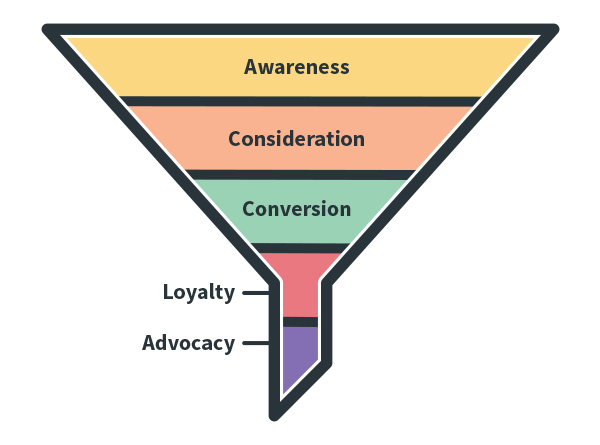
Businesses must focus on extending the bottom of the marketing funnel beyond the purchase stage to two more stages – customer loyalty and brand advocacy.
Customer loyalty
This is the post-purchase stage where the customer has already purchased your product.
Companies create customer engagement and loyalty programs to engage with the customers post their purchase.
It ensures that customers stay loyal and would do repeat purchases of the product. This results in retaining existing customers.
The cost of retaining existing customers is much lesser than that of acquiring new customers, and hence retaining existing customers brings profits to the business.
Also, the existing customers have now experienced the product and are more likely to purchase it again, since they have already gone through the earlier stages of the funnel of awareness and consideration.
Loyalty Programs
Companies design loyalty programs that reward existing customers for repeat purchases.
Rewards could be in form of special discounts, redeemable reward points, special offers, gifts, special privileges, others.
This engages and encourages customers to keep purchasing again and induces customer loyalty.
Email marketing
Email marketing campaigns are used to engage with customers on a regular basis.
These emails keep customers updated about the company news, information & update about the products, and any special offers, discounts, festival sale, etc.
These emails can be personalized according to the customer lifecycle stage with the company and their past purchase behavior.
Along with email, app notifications and SMS are the channels used to engage with existing customers.
Brand Advocacy
The next stage is where loyal and satisfied customers are turned into brand advocates for the company. They would recommend and promote the company brand to others, thereby bringing in new customers.
Customer recommendations are highly effective since potential new customers tend to believe and trust existing customers more easily.
Companies focus on the post-purchase customer experience and keeping their customers happy and satisfied.
A robust customer service system that resolves any post-purchase customer issues and queries is one way to keep customers satisfied.
Also keeping customers engaged with a loyalty marketing program (as discussed above) is another way of keeping customers happy. In fact, the buzzword is to delight the customers at every stage.
Happy and loyal customers are then encouraged to become brand advocates and recommend the company products to their friends, families, and others. This brings in new customers at a negligible cost and is extremely profitable for the business.
WOM publicity
Companies encourage word of mouth (WOM) publicity by loyal customers.
Loyal customers are encouraged to provide testimonials which are then used in the marketing material that the company uses to bring in new custome
rs. Customers are also encouraged to write positive reviews regarding the products and share their experiences on social media.
Referral programs
Companies design referral programs wherein loyal customers are incentivized to recommend the company products and bring in new customers.
Special offers are given to their friends, families, and anyone else they would recommend to buy the product.
At the same time, customers are rewarded with cash prizes, gifts, vouchers for every new customer that they bring in.
How to create a marketing funnel?
So far this article would have given you a fair idea of the fundamental concept of a marketing funnel, the types of funnels in use, and how to use a funnel in influencing the customer journey from awareness to purchase.
All the details shared, such as the various stages of the funnel, the type of content, the tactics used, along with the examples, would give you a good understanding of how to create or design a marketing funnel.
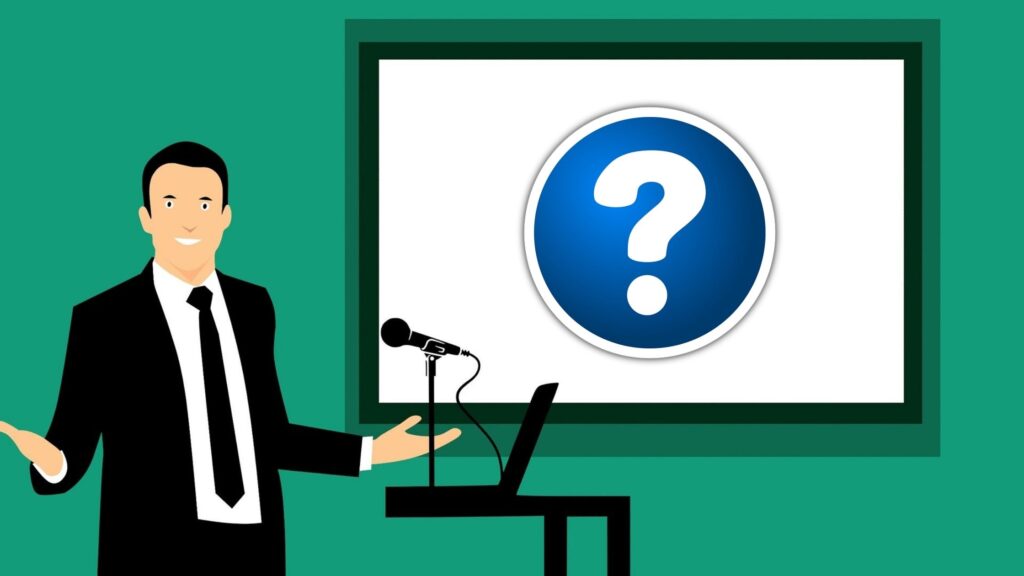
So here, I will discuss how to create a marketing funnel and the steps involved in it.
The details discussed in these steps have been already covered earlier in this post.
Let’s look at the 5 steps in creating an effective marketing funnel for any business.
1. Understand your target audience
This is the first and most important step in creating a marketing funnel.
In-depth study of the target audience through research and understanding their dreams, aspirations, challenges, and pain points are very important to design an effective funnel.
Understand their needs, their media consumption patterns, and their behavioral triggers. Establish the customer persona of your typical target customers.
2. Establish customer journeys for your business
The next step is to understand and establish the various customer journeys or paths your target customers can take to purchase your product.
The customer journeys depend on the nature of the business, the type of product or service, and the target audience profile.
The things you should consider here are the different avenues for target customers to interact with your business, their preferred channels, the challenges in their purchase journey that you need to influence, and others.
3. Determine the stages of your funnel
Once the customer journeys have been established, you decide the different stages of your marketing funnel.
As explained earlier, these stages could be broadly split into TOFU (awareness & attention), MOFU (consideration & evaluation), and BOFU (conversion or purchase).
Depending on the customer journeys, you can have various steps in your marketing funnel. These steps will broadly fit into the TOFU-MOFU-BOFU funnel model.
This was discussed in the various funnel examples, earlier in the article.
4. Decide on the marketing activities
Once you have established the various stages of the funnel, now you have to determine the marketing actions at each stage.
As discussed at the start of this article, the various stages in a funnel help us determine the marketing tactics to influence the target customers to move through the funnel.
These marketing tactics include the channels of communication and the content at each stage in the funnel.
The communication channels across various stages could be paid advertising, PR, SEO, social media, email marketing, webinars, telemarketing, others.
The content used at various funnel stages could be blog posts, social media posts, promotional videos, infographics, website content, e-books, case studies, product reviews, sales videos, product demo videos, customer testimonials, FAQs, and others.
The type of channel & content that should be used at the different stages of the funnel has been explained earlier in the article.
5. Implement, measure, and evaluate
The final step is to implement the marketing funnel, as designed through the first four steps.
Start slow, evaluate results, and then scale up.
Measure and evaluate results at every step and every stage of the funnel.
Check which tactics are working and which are not. Observe and measure the customer response at every step.
To measure the effectiveness, you need to define marketing KPIs at every stage in the funnel.
Take corrective actions, if needed, based on the results.
Marketing funnel vs Sales funnel
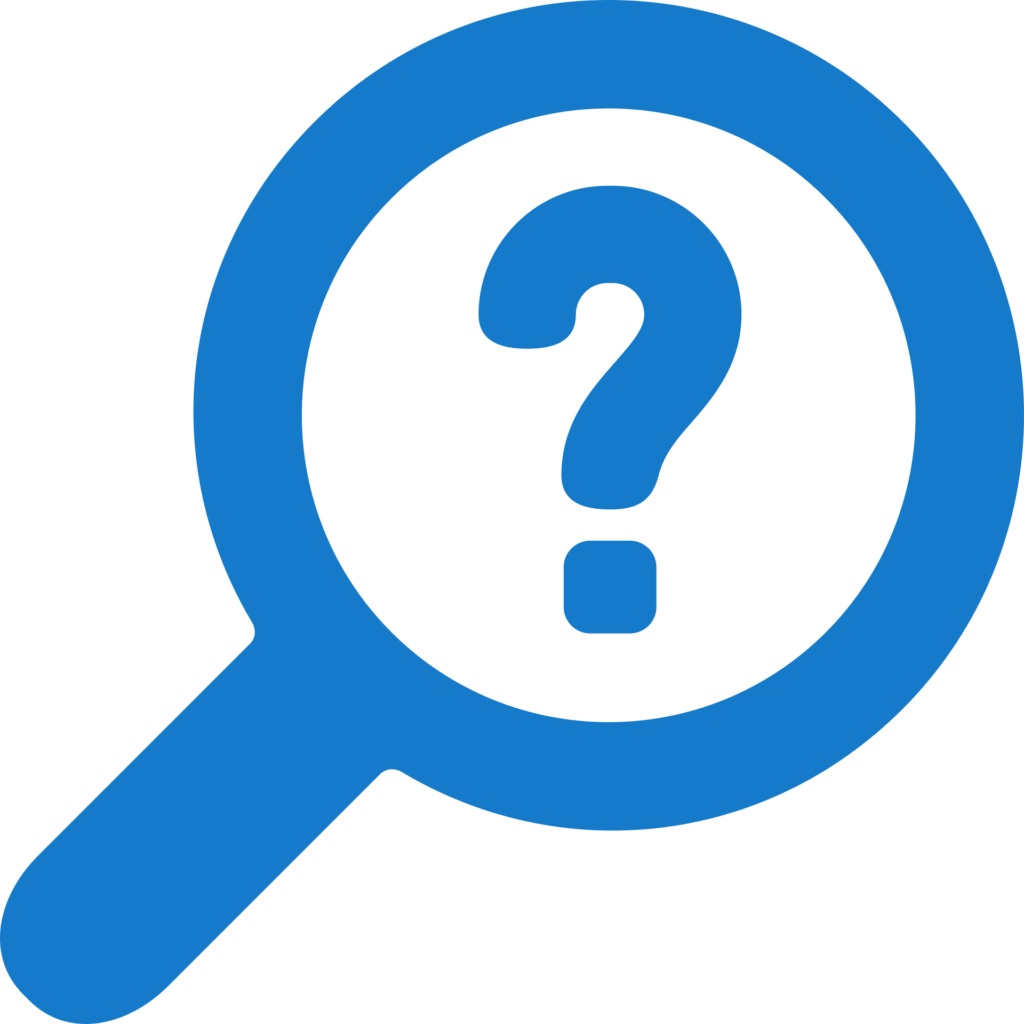
Many ask this question – what is the difference between a marketing funnel and a sales funnel?
In many companies, the terms marketing funnel and sales funnel are used interchangeably for the same funnel.
As we saw earlier in the article, the marketing funnel spans right from creating awareness at the top to converting prospects into purchases at the bottom.
This purchase that happens at the bottom end of the funnel is sales.
As we saw in the funnel extension section, some of these converted customers become loyal customers and make repeat purchases, this leads to further sales.
As such, sales is integrated into the marketing funnel, at the bottom end of the funnel.
The TOFU stage is about creating awareness and catching the attention of the target customers. This is the stage where leads are generated.
The MOFU stage is about consideration and evaluation. At this stage, cold leads are nurtured into warm leads and then further into hot leads.
The BOFU stage is where hot leads are converted into customers by inducing the purchase of the product. This is done via sales pitches, sales videos, sales pages, customer testimonials, giving attractive offers and incentives.
This bottom section of the marketing funnel is the sales funnel, where hot prospects are converted into sales. As you can see, the sales funnel is part of the marketing funnel.
8 Advantages of a Marketing funnel
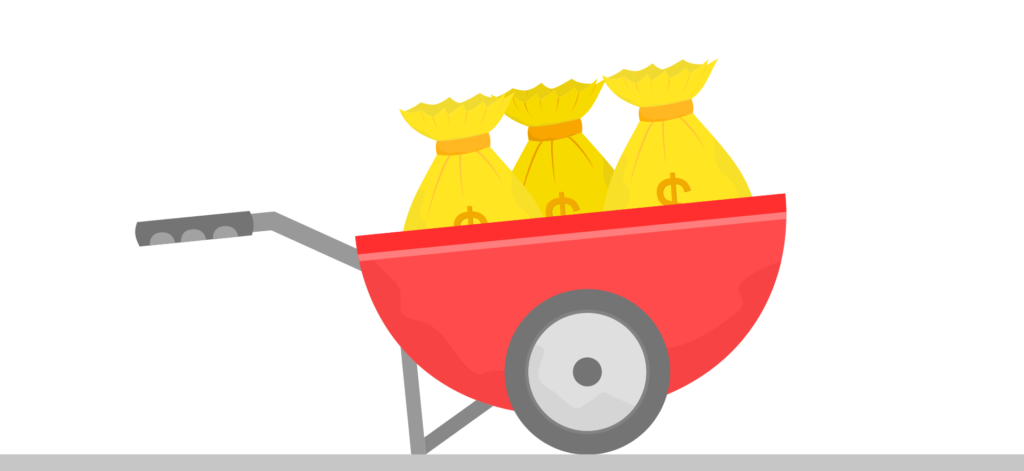
There are many advantages of implementing a marketing funnel strategy for any business, as you may have realized during the course of this article.
Let’s look at each one of them.
1. Gives direction to marketing actions
The marketing funnel gives a clear direction and purpose to marketing initiatives and brings in sharpness and focus.
Marketing actions become highly customer-centric. They are in sync with the various stages of the customer journey, assisting the customers at each step in trying to solve their challenges and needs.
2. Improves effectiveness of content & communication
Marketing content and communication become purpose-driven, focused on assisting and helping customers move through the funnel.
It is segmented and targeted at the various stages of the funnel and the customer journey.
It makes the funnel effective in driving results.
3. Improves customer interaction
A Marketing funnel improves the quality of interaction with the customers.
As the communication and content are highly relevant to each stage of the customer journey, it engages customers in a meaningful interaction.
4. Reduce wastage
It minimizes wastage in the marketing effort, resources such as people, and marketing budget. This is because the marketing effort and resources are targeted at the various stages of the funnel.
The marketing funnel helps in channelizing the efforts of the marketing team. The team has a clear focus and purpose, with their efforts well utilized without much wastage.
5. Assists lead management
A marketing funnel is an effective way to manage the entire lead process, starting from the lead generation at the top of the funnel to lead nurturing at the middle and then lead conversion at the bottom of the funnel.
For businesses that thrive on leads, this proves to be the most effective strategy to bring in new customers and grow the business efficiently.
6. Improves measurability
Marketing funnel assists measurability by breaking down the customer journey into various steps and enabling measurement of the response at each stage.
This allows businesses to take corrective actions and improve effectiveness at every step.
7. Improves estimation
As the marketing funnel allows you to measure results at every step, it can over time help predict the conversion and sales volume.
Businesses can estimate the correlation between the marketing efforts at the top of the funnel with expected sales at the bottom.
This correlation can be helpful to scale up sales and revenue through the funnel.
8. Increases sales
An effective marketing funnel strategy ensures that more customers are pushed through the funnel towards the bottom end of purchase. It results in increased sales and profits for the business.
Conclusion
That brings us to the end of this blog post.
I am hoping that this article has given you a deep understanding of the concept of a marketing funnel, how to create one for your business, how to use it, and the numerous benefits it brings to the business.
In today’s world of digital marketing, implementing a marketing funnel strategy is imperative to any business, particularly to those businesses that rely on the internet.
I would deeply appreciate any feedback, comments, and questions from your end regarding this article or in general about marketing.
Please feel free to write to me in the comments section below, and I will respond to you.
Till the next article!

